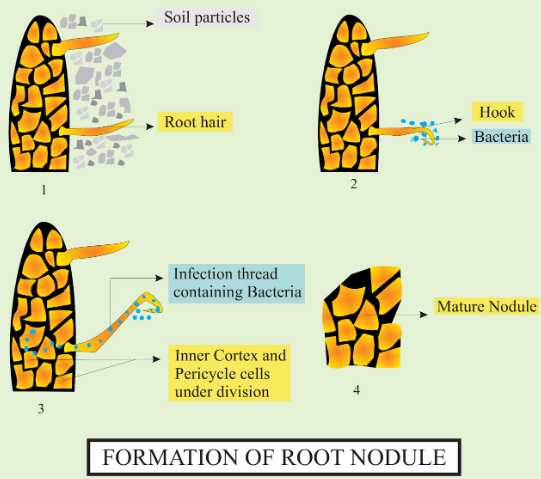
Nodulated roots occurs in
(a) Leguminosae
(b) Malvaceae
(c) Euphorbiaceae
(d) None of the above
Answer
454.5k+ views
Hint: Nodulated roots were found in the pulses which come under the family Fabaceae. The nodulated roots are generally taproot and it consists of symbiotic nitrogen-fixing bacteria which makes nodules between the roots.
Complete Answer:
Nodulated roots occur in family Leguminosae of class Dicotyledonae which is also known as family Fabaceae and consists of main pulses. The plants of Leguminosae are generally herbs, shrubs, trees, and climbers. Nodulated roots show symbiotic nitrogen fixation by bacterium Rhizobium leguminosarum and it also forms a direct vascular connection with the host plant for the exchange of nutrients. The bacteria form nodules while fixing nitrogen and the nodules are generally small, irregular in outgrowth. Bacteria when comes in contact with some chemicals the root get curl by which the rhizobia invade root tissue and proliferate within root hair. The nodules are pinkish internally due to the presence of pigment leghaemoglobin. The cell of the root nodule is large and tetraploid and consists of irregular polyhedral bacteria which are known as bacteroids. Bacteroides present inside the host membrane in the form of patches and the leghemoglobin present between the bacteroids and host membrane. Leghaemoglobin combines with oxygen and acts as an oxygen scavenger because nitrogenase enzymes work under anaerobic conditions, therefore, leghaemoglobin after combining with oxygen maintains the activity of nitrogenase by inhibiting the passage of oxygen toward nitrogenase.
So, the correct answer is ‘Leguminosae’.
Note:
Fixation of nitrogen in the root is controlled by root nod genes like a nod, if, and fix. The combination of plant growth hormones like cytokinin and auxin which are produced by nitrogen-fixing bacteria and plants helps to promote cell growth, cell division, and nodule formation.

Complete Answer:
Nodulated roots occur in family Leguminosae of class Dicotyledonae which is also known as family Fabaceae and consists of main pulses. The plants of Leguminosae are generally herbs, shrubs, trees, and climbers. Nodulated roots show symbiotic nitrogen fixation by bacterium Rhizobium leguminosarum and it also forms a direct vascular connection with the host plant for the exchange of nutrients. The bacteria form nodules while fixing nitrogen and the nodules are generally small, irregular in outgrowth. Bacteria when comes in contact with some chemicals the root get curl by which the rhizobia invade root tissue and proliferate within root hair. The nodules are pinkish internally due to the presence of pigment leghaemoglobin. The cell of the root nodule is large and tetraploid and consists of irregular polyhedral bacteria which are known as bacteroids. Bacteroides present inside the host membrane in the form of patches and the leghemoglobin present between the bacteroids and host membrane. Leghaemoglobin combines with oxygen and acts as an oxygen scavenger because nitrogenase enzymes work under anaerobic conditions, therefore, leghaemoglobin after combining with oxygen maintains the activity of nitrogenase by inhibiting the passage of oxygen toward nitrogenase.
So, the correct answer is ‘Leguminosae’.
Note:
Fixation of nitrogen in the root is controlled by root nod genes like a nod, if, and fix. The combination of plant growth hormones like cytokinin and auxin which are produced by nitrogen-fixing bacteria and plants helps to promote cell growth, cell division, and nodule formation.

Recently Updated Pages
Master Class 9 General Knowledge: Engaging Questions & Answers for Success

Master Class 9 English: Engaging Questions & Answers for Success

Master Class 9 Science: Engaging Questions & Answers for Success

Master Class 9 Social Science: Engaging Questions & Answers for Success

Master Class 9 Maths: Engaging Questions & Answers for Success

Class 9 Question and Answer - Your Ultimate Solutions Guide

Trending doubts
State and prove Bernoullis theorem class 11 physics CBSE

What are Quantum numbers Explain the quantum number class 11 chemistry CBSE

Who built the Grand Trunk Road AChandragupta Maurya class 11 social science CBSE

1 ton equals to A 100 kg B 1000 kg C 10 kg D 10000 class 11 physics CBSE

State the laws of reflection of light

One Metric ton is equal to kg A 10000 B 1000 C 100 class 11 physics CBSE




